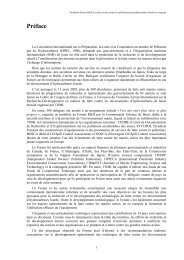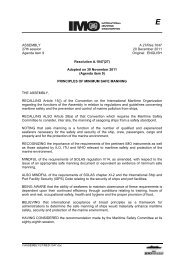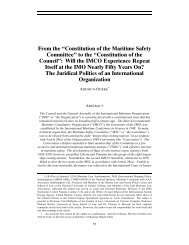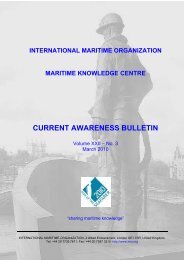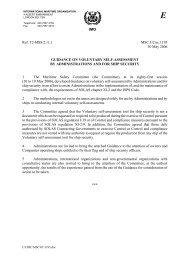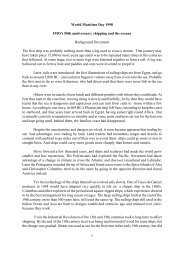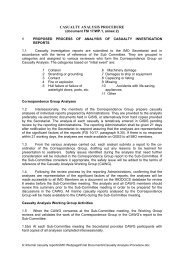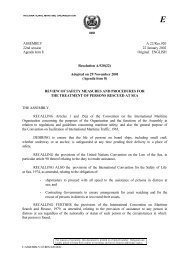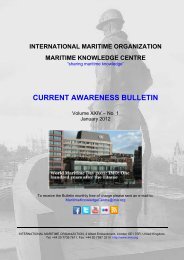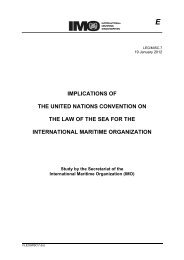Radioactive Waste Disposal at Sea: Public Ideas ... - IMO
Radioactive Waste Disposal at Sea: Public Ideas ... - IMO
Radioactive Waste Disposal at Sea: Public Ideas ... - IMO
Create successful ePaper yourself
Turn your PDF publications into a flip-book with our unique Google optimized e-Paper software.
202 Notes to pp. 35–42<br />
2. On policy entrepreneurs in American politics, see Kingdon 1984 and Polsby 1984.<br />
On policy entrepreneurship by EU officials, see Majone 1996a, especially chapter 4.<br />
3. Middle-range theories are often used in environmental studies, ide<strong>at</strong>ional analyses,<br />
and regime analyses. See, e.g., Liefferink 1996, pp. 40–57; Checkel 1997, pp.<br />
3–12; Stokke 1997, pp. 27–63.<br />
4. Major realist works include Carr 1939, Morgenthau 1948, Aron 1966, Waltz<br />
1954, Waltz 1979, and Gilpin 1981. For the recent deb<strong>at</strong>e, see Kegley 1995.<br />
5. On interest-based theory and reflective theory, see Keohane 1988. On neorealism<br />
and neoliberalism, see Nye 1988. For the recent deb<strong>at</strong>e, see Baldwin 1993. For<br />
the most widely quoted work on collective action problems, see Olson 1965. To<br />
analyze intern<strong>at</strong>ional cooper<strong>at</strong>ion, especially how and when public goods might be<br />
provided, interest-based analysis often draws on economists’ studies. For a good<br />
general discussion, see Miller 1997.<br />
6. Modern reflective or liberal theory, like its predecessors “functionalism” and<br />
“neofunctionalism,” stresses domestic society’s impact on intern<strong>at</strong>ional society,<br />
interdependence, and intern<strong>at</strong>ional institutions. Major liberal works include<br />
Deutsch et al. 1957 and E. Haas 1958. For the classic outline of functionalistic intern<strong>at</strong>ional<br />
theory, see Mitrany 1966. E. Haas (1980, 1983, 1990) has extensively<br />
examined the cognitive and philosophical found<strong>at</strong>ion of intern<strong>at</strong>ional cooper<strong>at</strong>ion.<br />
For empirical work in this tradition, see Haas et al. 1977.<br />
7. See P. Haas 1990b, p. 348.<br />
8. For comparable cases, see George and McKeown 1985, pp. 21–58.<br />
9. See, e.g., Orren 1990, pp. 22–24.<br />
10. In<strong>at</strong>tention to the views and influence of mass publics is quite widespread<br />
among intern<strong>at</strong>ional politics scholars, including a number of recent ide<strong>at</strong>ional studies<br />
in intern<strong>at</strong>ional politics. For a discussion, see Jacobsen 1995.<br />
11. This definition comes close to how Kingdon (1984, pp. 129–130, 188–193,<br />
214–215) defines policy entrepreneurs. For a promising system<strong>at</strong>ic approach drawing<br />
on both political and economic theory, see Schneider and Teske 1992.<br />
12. On policy windows, see Kingdon 1984, pp. 173–204.<br />
13. On de facto n<strong>at</strong>ural coalitions, see Sebenius 1992, pp. 352–353.<br />
14. The seminal article on this metaphor for domestic-intern<strong>at</strong>ional interaction is<br />
Putnam 1988.<br />
15. Furthermore, Kelman (1990, p. 40) notes parenthetically, “the organiz<strong>at</strong>ion of<br />
environmentalists into interest groups generally followed environmental legisl<strong>at</strong>ion,<br />
r<strong>at</strong>her than preceded it.”<br />
16. See Majone 1989, pp. 35–36.<br />
17. For examples, see Kingdon 1984, p. 189.<br />
18. The terms issue network, policy community, and policy subsystems have been<br />
used to describe informal networks of policy specialists active in setting agendas<br />
and formul<strong>at</strong>ing policies. On issue networks, see Heclo 1978, pp. 87–124. On policy<br />
communities, see Kingdon 1984, pp. 122–128. On policy subsystems, see<br />
Sab<strong>at</strong>ier 1988, p. 131.




